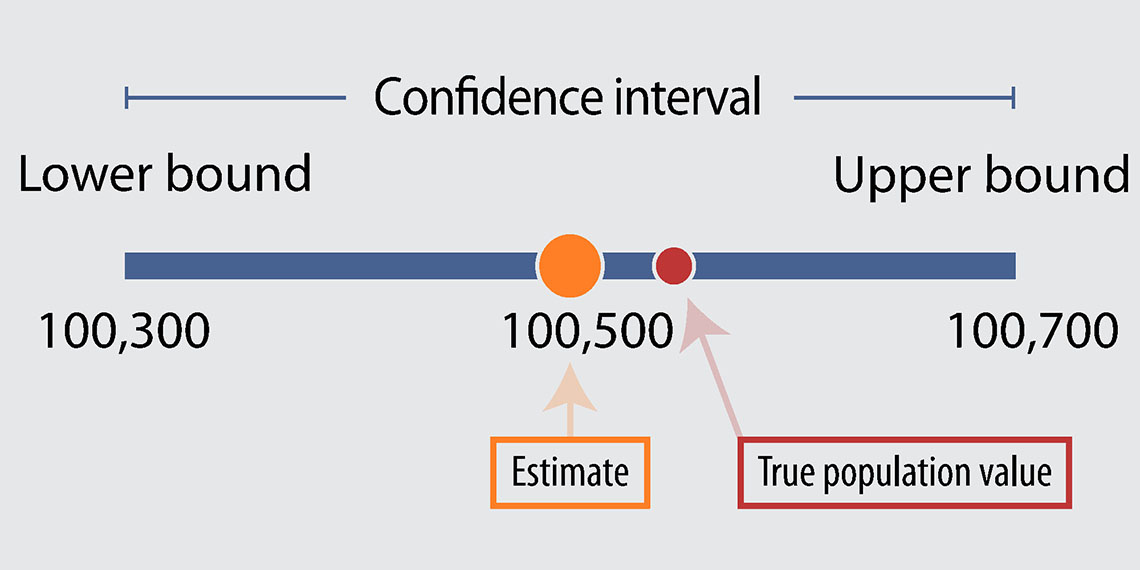Understanding confidence intervals for the 2021 Census
For the 2021 Census, Statistics Canada is disseminating confidence intervals for many long-form estimatesNote 1. This is the first time confidence intervals are provided for the Canadian census.
What are confidence intervals?
A confidence interval is a range of possible values for the population quantity being estimated from a survey sample. It is expressed by two numbers that indicate the upper and lower bounds of this range. For example, if the estimated number of employed persons in a city is 100,500, the confidence interval might be expressed by the two numbers 100,300 and 100,700. This interval covers the whole range of values between the two numbers. By including a range of values, not just the actual estimate, the confidence interval accounts for the uncertainty of estimates.
Figure 1. Confidence interval

Description for Figure 1
This diagram illustrates a confidence interval's upper and lower bound. In this diagram, the lower bound is 100,300 and the upper bound is 100,700. These bounds are presented along a blue bar. The estimate number, 100,500, is identified by an orange circle on the blue bar. The true population count is identified on the blue bar by a red circle (to the right of the orange circle).
A confidence interval is also associated with a confidence level, which is expressed as a percentage. It indicates how certain one can be that the confidence interval contains the true population value.
To produce long-form estimates, a sample of the population is selected and data are collected from respondents in the sample. Then, the data undergo processing and estimates are produced. All these steps involve certain elements of randomnessNote 2 and could yield slightly different estimates and confidence intervals if repeated. The confidence level for the confidence intervals produced for long-form estimates is 95%. This means that even if different estimates were produced through the same process multiple times, the confidence intervals would contain the true population value 95% of the time.
Research and simulations have been done using a scientific approach to ensure that the confidence intervals for long-form estimates are constructed using adequate statistical methods. Different methods are used to calculate the confidence intervals for different types of statistics.
How confidence intervals can be interpreted
Confidence intervals are a useful data quality indicator. For instance, they can help determine whether differences between values are statistically significant.
Confidence intervals are measured in terms of width. The more uncertainty there is, the wider the confidence interval will be. If two estimates are equal, but one has a wider 95% confidence interval than the other, then the estimate with the wider interval has greater uncertainty.
Where to find confidence intervals for the 2021 Census long-form estimates
Confidence intervals will usually be available in data tables accessible through the Statistics Canada website.
In some cases, they will be available only via custom requests. These include:
- disaggregated data tables with a very large number of cells
- multi-cycle tables
- tables including both long-form and short-form estimates.
Confidence intervals may be obtained for these tables by submitting a custom request through our online form, by emailing us at infostats@statcan.gc.ca, or by calling 1-800-263-1136 (toll free) or 1-800-363-7629.
Because of system limitations, tables containing confidence intervals that are provided in response to custom requests may not be available in the same formats as the 2021 Census data tables on the Statistics Canada website.
For more information
Sampling and Weighting Technical Report, Census of Population, 2021, Statistics Canada Catalogue no. 98-306-X (to be released in 2023).
2021 Census Data Quality Guidelines, Census of Population, 2021, Statistics Canada Catalogue no. 98-26-0006.
- Date modified: